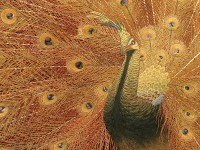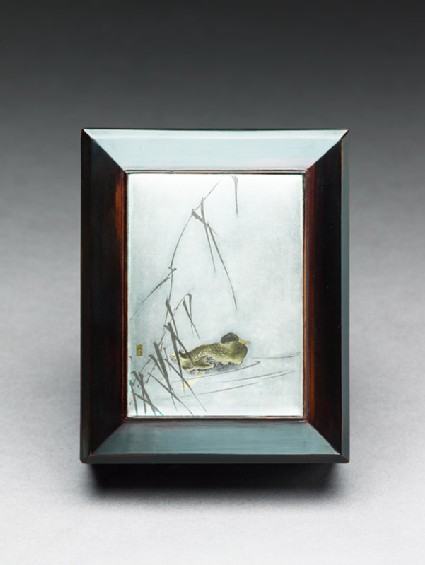Threads of Silk and Gold: Ornamental Textiles from Meiji Japan
(from 9th Nov 2012 until 27th Jan 2013)Discover exquisite embroideries, dyed silk and velvet panels, tapestries, and appliqué works

- Reference URL
Actions
Box with plaque depicting a duck swimming past reeds
-
Details
- Associated place
- Date
-
probably before 1908
Meiji Period (1868 - 1912)
- Artist/maker
-
Kajima Ikkoku II (1846 - 1925) (engraver)after Watanabe Seitei (1851 - 1918) (artist)
- Material and technique
- wood, covered in black lacquer, inset with metal plaque inlaid with mixed metals and with incised decoration; nashiji lacquer decoration inside
- Dimensions
- 4.2 x 8.7 x 10.3 cm (height x width x depth)
- Material index
- Technique index
- Object type index
- No. of items
- 2
- Credit line
- Presented by Sir Herbert Ingram, 1956.
- Accession no.
- EA1956.1787
-
Further reading
Impey, Oliver, and Joyce Seaman, Japanese Decorative Arts of the Meiji Period 1868-1912, Ashmolean Handbooks (Oxford: Ashmolean Museum, 2005), no. 29 on p. 62, p. 8, illus. pp. 62-63
Impey, Oliver, ‘Reflections upon the Arts and Crafts of Meiji Period Japan with Reference to the Collection of the Ashmolean Museum’, Oriental Art, 42/3, (Autumn 1996), p. 17, illus. p. 17 fig. 18
Oxford: Ashmolean Museum, 9 November 2012-27 January 2013, Threads of Silk and Gold: Ornamental Textiles from Meiji Japan, Clare Pollard, ed. (Oxford: Ashmolean Museum, 2012), fig. 81 p. 100
Glossary (2)
lacquer, nashiji
-
lacquer
Chinese and Japanese lacquer is made from the sap of the lacquer tree, which is indigenous to Eastern China. It is applied to wood as a varnish or for decorative effect. In India and the Middle East, lacquer is made from the deposit of the lac insect.
-
nashiji
(‘pear skin ground’) tiny, irregularly shaped flakes of gold embedded in amber coloured wet lacquer and then polished to a fine sheen
Past Exhibition
see (1)-

Threads of Silk and Gold: Ornamental Textiles from Meiji Japan
(from 9th Nov 2012 until 27th Jan 2013)
Location
-
- currently in research collection
Objects are sometimes moved to a different location. Our object location data is usually updated on a monthly basis. Contact the Jameel Study Centre if you are planning to visit the museum to see a particular object on display, or would like to arrange an appointment to see an object in our reserve collections.
Publications online
-

Japanese Decorative Arts of the Meiji Period
Soft metal plaque with a duck swimming past reeds. Set into the lid of a plain black lacquer box. Engraved signature: Ikkokusai.
Kajima Ikkokku II (1846-1925), who worked in Tōkyō, was the eldest son of Ikkoku I (c. 1820-1882) and was called the Mitsutaka until his father’s death, when he inherited the name. His gō was Ikkokusai. He won a Certificate of Merit at the Third National Industrial Exposition of 1890 and exhibited both at the St. Louis Exposition in 1904 and the Japan-British Exposition in 1910 where his work was illustrated in the catalogue, no. 199, a vase with nunome decoration, and no. 200, a double-fan-shaped incense box.
This miniature was purchased in Japan by Sir Herbert Ingram on his honeymoon in 1908, for 30 yen, as ‘box in metal design by Watanabe’. This refers to the artist Watanabe Seitei who supplied designs for several artists or companies, most notably the cloisonné company of Namikawa Sōsuke [see EA2000.50, EA1994.35 and EA1990.4]. The image here is quite consistent with his style, and even without the documentation, would have been attributed to Seitei. Ingram was a major benefactor of the Ashmolean and the high quality of his Japanese collections has been overshadowed by his remarkable Chinese collections, given in 1956.
Notice
Objects from past exhibitions may have now returned to our stores or a lender. Click into an individual object record to confirm whether or not an object is currently on display. Our object location data is usually updated on a monthly basis, so please contact the Jameel Study Centre if you are planning to visit the museum to see a particular Eastern Art object.
© 2013 University of Oxford - Ashmolean Museum





